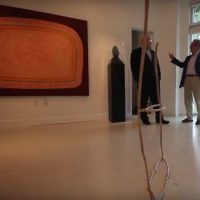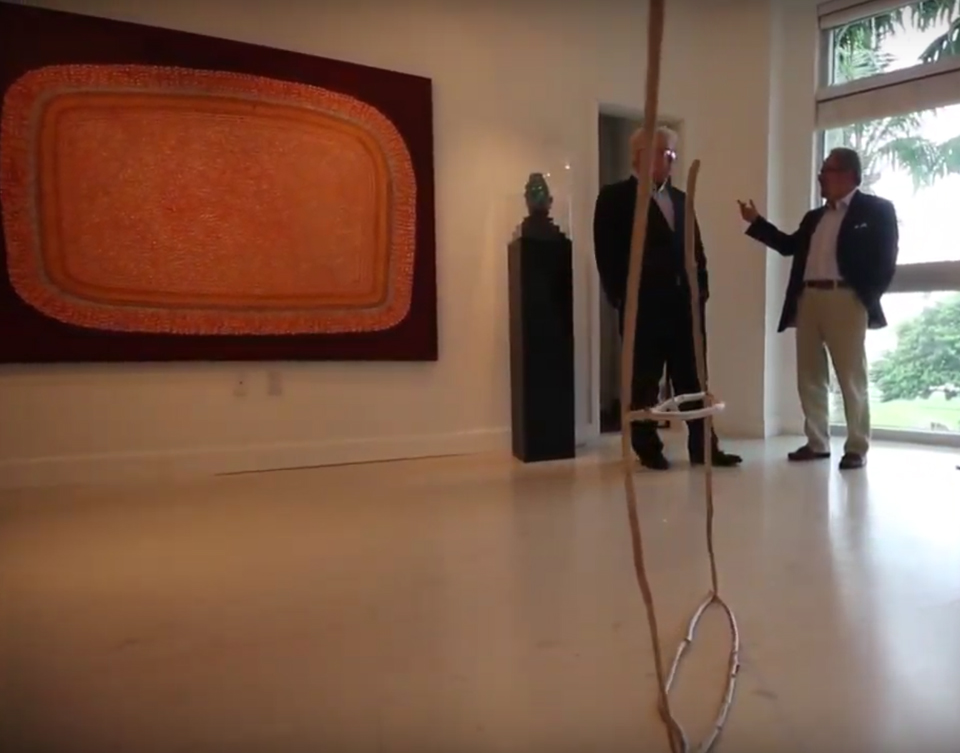A New Spin Every Year

Editor’s Note: In 2006, noted art critic Elisa Turner wrote a profile of Debra and Dennis Scholl for ARTNews magazine, focusing on the Scholl’s unusual practice of allowing a different curator every year to arrange and hang artwork from the Scholl’s collection. The curated exhibition is on the display in the Scholl’s home for one full year, and then the process is repeated. With permission of Elisa Turner and ARTNews magazine, ArtSpeak is pleased to present Turner’s article. You can also view our Inspico video discussion with Dennis Scholl about the Scholl collection.
IN THE LATE 1990s, Dennis and Debra Scholl faced a discouraging fact about themselves as collectors of contemporary art. The couple bought with confidence, but they didn’t know how best to display their purchases in their Miami Beach house. “We were OK picking art for the collection,” says Dennis, “but when it came to hanging, we were lousy.”
A visiting New York dealer, Casey Kaplan, helped bring the Scholls to this realization by poking fun at them for always displaying their new purchases over the living-room fireplace. But what really pushed the pair to ask for help was the delight they felt when, in 1999, Douglas Fogle, then a curator at the Walker Art Center in Minneapolis, reinstalled their collection, which at that time was focused on photography. “It was an epiphany for us; it was, like, oh my gosh, everything looks fabulous,” says Dennis, describing how the works “talked to each other” after Fogle rearranged them.
The Scholls were so delighted that they adopted an unusual practice. Each year they invite a curator to rehang their collection and promise that his or her choices will stay up for one year. “Curating is really an artful process—in much the same way I think collecting is an artful process sometimes—but displaying work is a very artful process,” notes Dennis. Their willingness to experience their collection through the eyes of a different curator each year has been so absolute that they have allowed their house—a two-story white stucco 1934 Streamline Moderne—to undergo major changes to accommodate curators’ visions. Over time, they have ditched bookshelves, their dining-room table (since returned), the television in the den, and the living room fireplace.
The fireplace went first. After Fogle completed his work, the Scholls realized that he had left out a photograph by Thomas Demand, a recent purchase of which they were especially proud. They protested to Fogle, who told them to hang the photo on a certain wall in the living room. “We said, ‘Douglas, there’s a fireplace there,’” recalls Dennis, “and he said, ‘Well, take it out.’ And so we did.”
More changes followed. Two windows in the den are now covered with white drywall panels. The room that was formerly used for watching television has become a small gallery, with a painting by Richard Prince, a video by Paul Pfeiffer, and a sculpture by Wade Guyton. These days the Scholls watch television in the kitchen or in the bedroom.
Their house has become “more like a museum with a bedroom,” says Dennis, but even the bedroom hasn’t escaped curatorial alterations. The eighth and most recent guest curator, Debra Singer, executive director of The Kitchen in New York, recommended that the sheets be replaced. “They contrasted with the art she put up,” explains Debra Scholl. “They had gold trim, which she didn’t like.” The sheets were replaced.
Over the bed, Singer lined up Mark Grotjahn’s Untitled (black & cream butterflies), 2005, a set of geometric drawings. Dara Friedman’s video loop Government Cut Freestyle (1998) is near the door. “I think it’s one of the most beautiful things she’s done,” says Dennis of the video.
The Scholls invite the guest curator to stay with them for a few days in early autumn, and then throw an outdoor party to celebrate the completion of his or her labors. They provide technical assistance but stay out of the decision-making process.
“We’re here to give them whatever equipment they need, a hammer or this or that,” says Debra. “I think they work at different paces, but on the whole it usually takes about three days” for the curators to complete a rehanging, she says. “They’ve generally been to the house before, and we send them a big book of all the art that we have. We ask which artists they definitely don’t want to hang and which artists they definitely want to hang. We get everything off the walls, so when they come here it’s pretty much a blank palette. We do the party to make sure they get finished.” The Saturday night barbecue and unveiling of the new “exhibition” has become a fall tradition for artists and other members of the South Florida arts community.
Singer chose to display more than 60 works from the collection, including installations, paintings and drawings, videos, and photographs. Many of the couple’s recent purchases, including works by Miami-based artists Hernan Bas, Ali Prosch, and Martin Oppel, are featured.
In the dining room is Black House (2005), a thickly textured painting by Francesca DiMattio that “is about order and entropy” and “aggressively tackles issues of both representation and abstraction within painting,” according to Singer. In the master bath, she placed Self-Portrait (1993), a photograph by Catherine Opie, which shows the artist’s back scarred by a bloody drawing carved into her flesh. The image, of two women next to a house, has the stilted quality of children’s art. Although Singer vowed not to be like the other curators, all of whom have hung this piece, she changed her mind at the last minute and included it.
After the Contemporary Museum in Baltimore and the Palm Beach Institute of Contemporary Art organized a show of the Scholls’ photography collection in 2003, they decided that they were ready to move on. “We knew what we wanted to get, we knew what we were supposed to get, and we knew what worked,” explains Dennis. “It became a little less challenging, because we like cutting-edge work.”
They changed their emphasis from photography to contemporary work in various media about two years ago, shortly after some of the artists they had concentrated on, like Olafur Eliasson, began to produce works in other media. At one point, Eliasson’s swiveling cast-aluminum-and-glass sculpture Kaleidoscope/Telescope (2001) displaced their dining room table. Now the work is in the Florida Room (sunroom), sharing a view of Biscayne Bay with How to Find Your Way If You Are Lost at Sea (2002), a commissioned installation by Jason Dodge that refers to a constellation seen from the couple’s backyard in the winter.
“We don’t really feel constrained by the medium anymore; it was an interesting shift for us. It felt right,” says Dennis, reflecting on their turn away from photography. Their collection now numbers between 350 and 400 works. Most of it is stored in their warehouse in Wynwood, Miami’s downtown art district.
The Scholls are both attorneys and real estate investors. Dennis describes himself as a venture capitalist; he cofounded Betts & Scholl wines in partnership with master sommelier Richard Betts of Aspen, Colorado, where the Scholls have a second home. Artists the Scholls collect have designed labels for the bottles.
Raised in Miami, the Scholls met on their first day of law school at the University of Miami. They have been interested in art for a long time; the first work they bought together, in 1978, was a lithograph by Robert Motherwell. In recent years they have taken leading roles in collectors’ groups at the Guggenheim Museum in New York and at Tate Modern in London. In 2005 they helped the Miami Art Museum form its Collectors Council, which raises funds for acquisitions and cultivates novice collectors by arranging studio visits in Miami and other cities.
The Scholls hope to encourage artists to work with future curators in the presentation of their works, as Singer did with Kelley Walker, whose Schema: Aquafresh plus Crest with Whitening (riot), 2004, based on an iconic photo of a race riot in Birmingham, Alabama, was installed as wallpaper in the foyer. The couple would also like to commission more work for their home, as they did in 2003, when they asked Jim Lambie to make a site-specific work for their spiral staircase. His Zobop Stair is a trippy piece, with colorful vinyl tape outlining a dizzying path up and down. It is still in place, thanks to a few repairs made with tape Lambie provided. Hanging above it on the curving staircase wall is Thomas Hirschhorn’s sparkly sculptural relief Necklace CNN (2002), which mimics rap artists’ bling.
The Scholls appreciate the way each curator puts a new spin on their evolving collection. With each annual rehang, they experience the way the artworks “talk to each other” in a different conversation. One juxtaposition they are currently enjoying is Singer’s pairing of Adam Helms’s fastidiously detailed drawing Portrait as Full Combatant (2004) with a color photograph by Fergus Greer, Leigh Bowery: Session1/Look 2/November1988, which greets visitors in the main hallway.
Both are portraits of figures whose identity is ambiguous. The soldier brandishing a weapon in Helms’s drawing seems to be wearing a buffalo- head mask. “I like the drawing technique a lot,” says Debra. “The image is really bizarre to me. You don’t know if it’s a mask; you don’t know if it’s half man, half animal.” The portrait of Bowery, the late British fashion designer and drag queen, is equally flamboyant. “Leigh has a lot of cleavage,” says Dennis. “He looks like a woman—or like a man trying to look like a woman.” This pairing, Dennis adds, is a “perfect example of what the curators do that we would not.
“What are you looking at?” Dennis says of the Helms. “You automatically think that might be a guy because it’s a soldier, but you really don’t know.” Of the Bowery photo, he says, “You think automatically that might be a woman because of the cleavage, but you don’t know. These are things that we would never see. We try to see them, but I don’t know that we are successful.”


